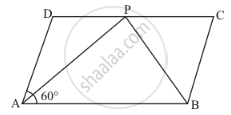Advertisements
Advertisements
Question
PQRS is a quadrilateral, PR and QS intersect each other at O. In which of the following case, PQRS is a parallelogram?
∠P = 100°, ∠Q = 80°, ∠R = 95°
Solution
We have a quadrilateral named PQRS, with diagonals PR and QS intersecting at O.
∠P =100° , ∠Q = 80° ,∠R = 100°
By angle sum property of a quadrilateral, we get:
∠P + ∠Q + ∠R +∠S = 360°
100° + 80° + 100° +∠S = 360°
280° +∠S 360°
∠S = 80°
Clearly, ∠P = ∠R
And ∠Q = ∠S
Thus we have PQRS a quadrilateral with opposite angles are equal.
Therefore,
PQRS is a parallelogram.
APPEARS IN
RELATED QUESTIONS
In Fig., below, ABCD is a parallelogram in which ∠A = 60°. If the bisectors of ∠A and ∠B meet at P, prove that AD = DP, PC = BC and DC = 2AD.

In a parallelogram ABCD, determine the sum of angles ∠C and ∠D .
In a parallelogram ABCD, if `∠`B = 135°, determine the measures of its other angles .
In a parallelogram ABCD, write the sum of angles A and B.
In a parallelogram ABCD, if ∠A = (3x − 20)°, ∠B = (y + 15)°, ∠C = (x + 40)°, then find the values of xand y.
We get a rhombus by joining the mid-points of the sides of a
The figure formed by joining the mid-points of the adjacent sides of a rhombus is a
The figure formed by joining the mid-points of the adjacent sides of a parallelogram is a
P is the mid-point of side BC of a parallelogram ABCD such that ∠BAP = ∠DAP. If AD = 10 cm, then CD =
In the given Figure, if AB = 2, BC = 6, AE = 6, BF = 8, CE = 7, and CF = 7, compute the ratio of the area of quadrilateral ABDE to the area of ΔCDF. (Use congruent property of triangles)
